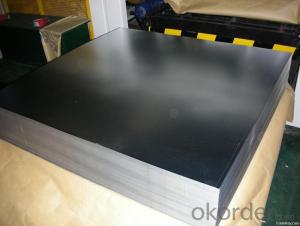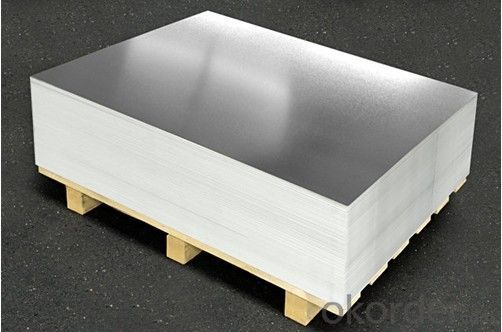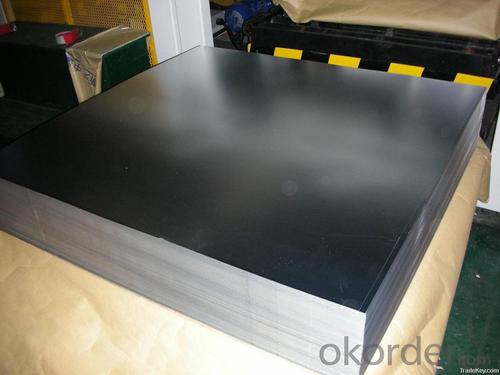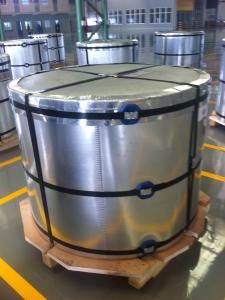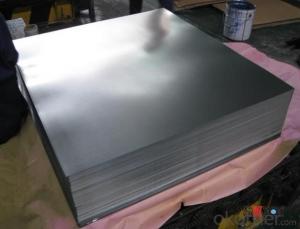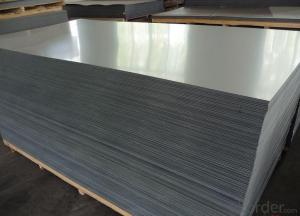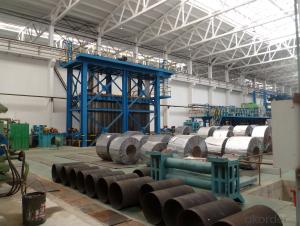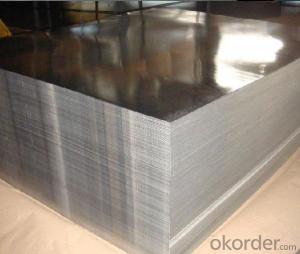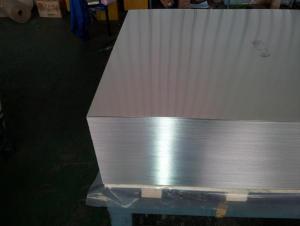Electrolytic Tinplate in Sheets for Food Cans Packing
- Loading Port:
- Tianjin
- Payment Terms:
- TT OR LC
- Min Order Qty:
- 25 m.t
- Supply Capability:
- 7000 m.t/month
OKorder Service Pledge
OKorder Financial Service
You Might Also Like
1.Structure of Electrolytic Tinplate in Sheets for Food Cans Packing Description
Electrolytic Tin Plate Coils and Sheets for Foods Metal Packaging, is one thin steel sheet with a coating of tin applied by electrolytic deposition. Tinplate made by this process is essentially a sandwich in which the central core is strip steel. This core is cleaned in a pickling solution and then fed through tanks containing electrolyte, where tin is deposited on both sides. As the strip passes between high-frequency electric induction coils, it is heated so that the tin coating melts and flows to form a lustrous coat.
2.Main Features of the Electrolytic Tinplate in Sheets for Food Cans Packing
Appearance – Electrolytic Tin Plate is characterized by its beautiful metallic luster. Products with various kinds of surface roughness are produced by selecting the surface finish of the substrate steel sheet.
Paintability and printability – Electrolytic Tin Plates have excellent paintability and printability. Printing is beautifully finished using various lacquers and inks.
Formability and strength – Electrolytic Tin Plates have got very good formability and strength. By selecting a proper temper grade, appropriate formability is obtained for different applications as well as the required strength after forming.
Corrosion resistance – Tinplate has got good corrosion resistance. By selecting a proper coating weight, appropriate corrosion resistance is obtained against container contents. Coated items should meet 24 hour 5 % salt spray requirement.
Solderability and weldability – Electrolytic Tin Plates can be joined both by soldering or welding. These properties of tinplate are used for making various types of cans.
Hygienic – Tin coating provides good and non toxic barrier properties to protect food products from impurities, bacteria, moisture, light and odours.
Safe – Tinplate being low weight and high strength makes food cans easy to ship and transport.
Eco friendly – Tinplate offers 100 % recyclability.
Tin is not good for low temperature applications since it changes structure and loses adhesion when exposed to temperatures below – 40 deg C.
3.Electrolytic Tinplate in Sheets for Food Cans Packing Images

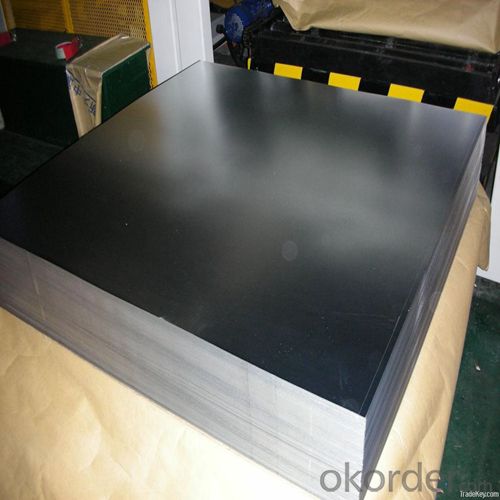

4.Electrolytic Tinplate in Sheets for Food Cans Packing Specification
Standard | ISO 11949 -1995, GB/T2520-2000,JIS G3303,ASTM A623, BS EN 10202
|
Material | MR,SPCC |
Thickness | 0.15mm - 0.50mm |
Width | 600mm -1150mm |
Temper | T1-T5 |
Annealing | BA & CA |
Coil Inner Diameter | 508mm |
Weight | 6-10 tons/coil 1~1.7 tons/sheets bundle |
Passivation | 311 |
Oil | DOS |
Surface | Finish,bright,stone,matte,silver |
5.FAQ of Electrolytic Tinplate in Sheets for Food Cans Packing
-What your tinplate material is used for ?
Tinplate is widely used for the packaging of products. Such as food cans,
beverage cans, pet cans, closures, general line cans and so on.
Printed Tinplate is offered!!
-How to place .an order or contact you ?
Please send us Email. we will give you a quick response in seconds .
- Q: What are the main challenges in tinplate warehousing?
- One of the main challenges in tinplate warehousing is the fragile nature of the product. Tinplate is susceptible to scratching, denting, and corrosion, so careful handling and storage procedures are necessary to prevent damage. Additionally, due to its relatively low melting point, tinplate requires proper temperature and humidity control to avoid deformation or discoloration. Lastly, tinplate is often packaged in large and heavy rolls, making logistics and space utilization critical challenges in warehousing operations.
- Q: How does tinplate handle exposure to different atmospheric conditions?
- Tinplate is known for its excellent resistance to atmospheric conditions. It can withstand exposure to various weather conditions, including high humidity, extreme temperatures, and even corrosive environments. The tin coating on the steel substrate acts as a protective barrier, preventing oxidation and corrosion, which helps in maintaining the integrity and durability of the tinplate. Overall, tinplate demonstrates superior performance when exposed to different atmospheric conditions.
- Q: What are the common printing techniques for tinplate?
- The common printing techniques for tinplate include lithography, offset printing, and silk-screen printing.
- Q: What are the main uses of tinplate?
- The main uses of tinplate include packaging food and beverages, manufacturing cans for aerosol products, creating decorative tin containers, and producing electrical equipment enclosures.
- Q: What are the different ways to seal tinplate cans?
- There are several methods commonly used to seal tinplate cans. These include double seam closure, soldering, adhesive bonding, and welding. Double seam closure is the most widely used method, where the can's lid and body are mechanically interlocked and sealed using pressure and rollers. Soldering involves melting a metal alloy to create a tight seal between the lid and body. Adhesive bonding uses specialized adhesives to bond the lid and body together. Welding involves fusing the lid and body using high heat to create a strong and permanent seal.
- Q: Can tinplate packaging be used for stationery products?
- Yes, tinplate packaging can be used for stationery products. Tinplate is a durable and versatile material that can be shaped into various sizes and designs, making it suitable for packaging pencils, pens, erasers, rulers, and other stationery items. It offers protection against damage, is environmentally friendly, and can be customized with attractive prints or embossing.
- Q: What are the different types of tinplate coatings available?
- There are several different types of tinplate coatings available, including tin-free steel (TFS), electrolytic chromium-coated steel (ECCS), and tin-coated steel. These coatings provide varying levels of protection against corrosion and can be chosen based on specific requirements and applications.
- Q: What are the main quality standards for tinplate?
- The main quality standards for tinplate include factors such as tin coating thickness, surface finish, dimensional accuracy, adhesion strength, resistance to corrosion, and overall product appearance. These standards ensure that tinplate meets the necessary requirements for various applications such as food packaging, electrical components, and decorative purposes.
- Q: How does tinplate compare to aluminum packaging in terms of cost?
- In terms of cost, tinplate tends to be more affordable compared to aluminum packaging.
- Q: Can tinplate be used for consumer electronics packaging?
- Yes, tinplate can be used for consumer electronics packaging. Tinplate is a durable material that provides excellent protection against moisture, corrosion, and physical damage. It is commonly used for packaging various consumer electronics such as mobile phones, tablets, and small appliances. Additionally, tinplate can also be easily printed on, allowing for attractive and customizable packaging designs.
Send your message to us
Electrolytic Tinplate in Sheets for Food Cans Packing
- Loading Port:
- Tianjin
- Payment Terms:
- TT OR LC
- Min Order Qty:
- 25 m.t
- Supply Capability:
- 7000 m.t/month
OKorder Service Pledge
OKorder Financial Service
Similar products
Hot products
Hot Searches
Related keywords

